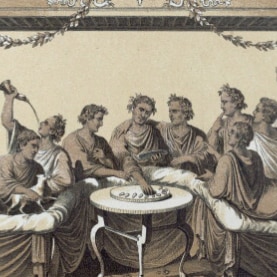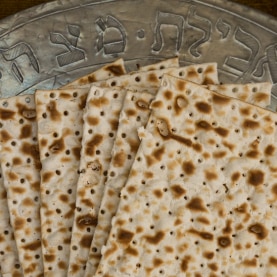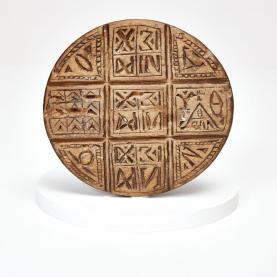The Last Supper
During his last supper, on the eve of the Hebrew Passover, Jesus foretold his sacrifice through the symbols of bread and wine, making amends for Adam and Eve’s original sin. He established what would become the Eucharist, or Holy Communion, a seminal meal, which Christians have continued to observe for over 2000 years.
A founding meal
In the New Testament, Jesus’ Last Supper took place on the eve of Hebrew Passover, which commemorates the day the people of Israel fled from Egypt, saved from the Tenth Plague by the sacrifice of the paschal lamb. Jesus gave the meal another meaning by foretelling his own sacrifice as the Divine Lamb, using bread and wine to represent his body and his blood. He took the bread, blessed it, broke it and gave it to his disciples saying, “Take, eat; this is my body.” Then, taking the cup, he said, “Drink from it, all of you. This is my blood of the covenant, which is poured out for many for the forgiveness of sins. I tell you, I will not drink from this fruit of the vine from now until that day when I drink it with you in my Father’s kingdom.” (Matthew 26: 26-29).
For Christians, these words represent the forgiveness of sins and of the original sin committed by Adam and Eve. They are a promise of resurrection and the foundation of what would become the Eucharist (from the Greek word eucharistia meaning ‘action of grace’). Jesus’ sacrifice would become a key celebration in Christianity.
A never-ending meal
Christians have reproduced Jesus’ final meal for over two thousand years. It is the focal point of worship for Catholics and is repeated every Sunday or, for the most devout, every day of the week. The altar, originally a simple wooden table, was later covered by a cloth to represent the family table and invite people to come and to share. The wine is reserved for the priests, while the unleavened hosts (from the Latin word hostia, ‘victim’) are shared by all. Protestants, however, share the bread and wine. The Communion ritual may vary depending on the community.
The Last Supper
Numerous artists have depicted Jesus’ final meal. The most famous work is certainly Leonardo da Vinci’s The Last Supper. This depiction has become such a part of collective memory that advertisers are not ashamed to use it. It has been copied and parodied countless times, to showcase various products from cars to clothes. This has sometimes given rise to heated debates.
SOUAN, Olivier, 2015. Commémorer la résurrection du Christ. Le Point Références, Le christianisme : rites et fêtes. Janvier-février 2015. pp. 20-21
Aurélie Godefroy, 2006. Rites et fêtes du catholicisme. France : Plon
Feinberg Vamosh, Miriam, 2011 (3e édition). Les nourritures aux temps de la Bible. France : Bibli’O
Philippe Walter, 2003. Mythologie chrétienne. Paris : Éditions imago
La Sainte Bible, dite Bible de Jérusalem, 1955, Paris : Le club français du livre.









